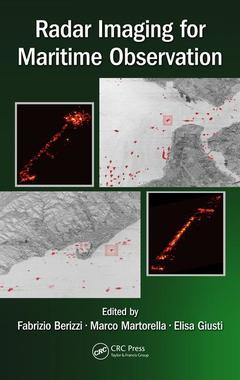Description
Radar Imaging for Maritime Observation
Signal and Image Processing of Earth Observations Series
Authors: Berizzi Fabrizio, Martorella Marco, Giusti Elisa
Language: English
Subjects for Radar Imaging for Maritime Observation:
Keywords
ISAR Image; Cross-range Resolutions; SAR; SAR Image; Radar imaging theory and system; Slow Time Domain; Passive ISAR; Range Profile; ISAR; Face Tough; Bistatic ISAR; 3D Interferometric ISAR; Issues Children Face Tough Issues; Oil Spill detection; NTR; Maritime and coastal surveillance; Bistatic Angle; Maritime traffic monitoring; Passive Radar; Spatial Frequency Domain; MF; Cross-range Direction; Radar Imaging; Aspect Angle; IPP; Motion Compensation; FARIMA Model; Tough Issues Face Tough Issues; Doppler Domain; Children Face Tough Issues Safe; Complex SAR Image; Southern Adriatic Sea
238.84 €
In Print (Delivery period: 15 days).
Add to cartPublication date: 06-2016
· 15.6x23.4 cm · Hardback
132.65 €
In Print (Delivery period: 14 days).
Add to cartPublication date: 11-2018
· 15.6x23.4 cm · Paperback
Description
/li>Contents
/li>Readership
/li>Biography
/li>
Based on the experiences of the Department of Information Engineering of the University of Pisa and the Radar and Surveillance System (RaSS) national laboratory of the National Interuniversity Consortium of Telecommunication (CNIT), Radar Imaging for Maritime Observation presents the most recent results in radar imaging for maritime observation. The book explores both the areas of sea surface remote sensing and maritime surveillance providing key theoretical concepts of SAR and ISAR imaging and more advanced and ad-hoc techniques for applications in maritime scenarios. The book is organized in two sections. The first section discusses the fundamentals of standard SAR/ISAR processing and novel imaging techniques, such as Bistatic, Passive, and, 3D Interferometric ISAR. The second section focuses on the applications and results obtained by processing real data from maritime observations like SAR image processing for oil spill, detection in SAR images and fractal analysis. Useful to both beginners and experts in maritime observation, this book provides several examples of (mainly space-borne) radar imaging of maritime targets. Nevertheless, the same principles and techniques apply to the case of manned or unmanned carriers and to ground and air moving targets.
PART I SAR and ISAR Signal Processing. Principles of Radar Imaging. SAR Processing. ISAR Processing. Bistatic ISAR. Passive ISAR. 3D Interferometric ISAR. PART II Applications. Detection of Ships from SAR Images. Oil Spill Detection with SAR Images. Non-Cooperative Moving Target Imaging. Passive ISAR for Harbor Protection and Surveillance. Blue Port Tra_c Monitoring via 3D InISAR Radar Imaging System.
Fabrizio Berizzi received the Electronic Engineering Laurea and PhD degrees from the University of Pisa (Italy) in 1990 and 1994 respectively. He has been a full Professor of the Univ. of Pisa since Nov. 2009. He teaches "Radar techniques", "Signal Theory" at the Univ. of Pisa", and "Digital signal processing" at the Italian Navy Academic. He is a IEEE Senior member since 2006. He has been working on ISAR, SAR and radar systems since 1990. More than 200 papers, three chapters of books and a book on radar imaging have been published. Since 1992 Prof. Berizzi has been involved in several scientific projects as a Principal Investigator funded by Univ. Ministry, Defence Ministry, Italian and European Space Agencies, Industries, Tuscany region, ESA (European Space Agency), European Defense Agency. Prof. FabrizioBerizzi is the vice-director of the (Radar and Surveillance Systems) National Laboratory of CNIT since Dec. 2010.
Marco Martorella received his Laurea degree in Telecommunication Engineering in 1999 (cum laude) and his PhD in Remote Sensing in 2003, both at the University of Pisa. He is now an Associate Professor at the Department of Information Engineering of the University of Pisa where he lectures "Fundamentals of Radar" and "Digital Communications" and an external Professor at the University of Cape Town where he lectures "High Resolution and Imaging Radar" within the "Masters in Radar and Electronic Defence". He is a regular visiting Professor at the University of Adelaide and at the University of Queensland in Australia. He is author of about 150 international journal and conference papers, three book chapters and a book entitled "Inverse Synthetic Aperture Radar Imaging: Principles, Algorithms and Applications". He has presented several tutorials at international radar conferences and organised a special issue on Inverse Synthetic Aperture Radar for the Journal of Applied Signal Processing. He is a member of the IET




